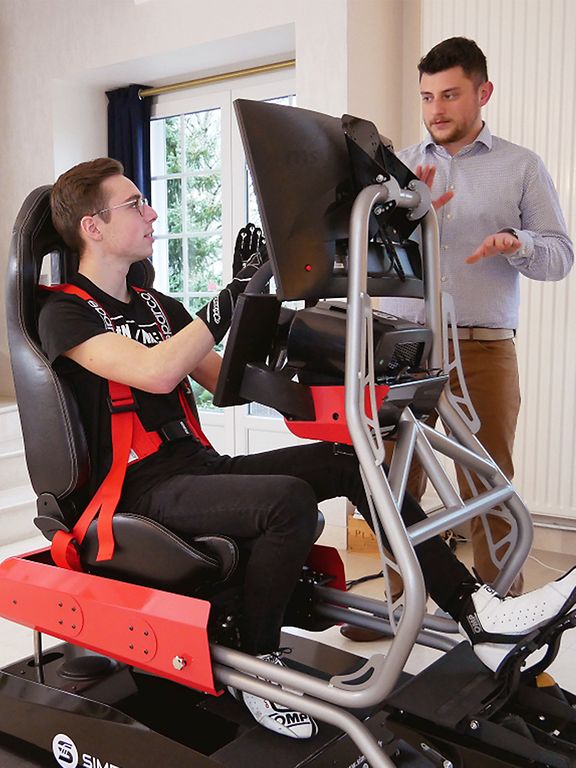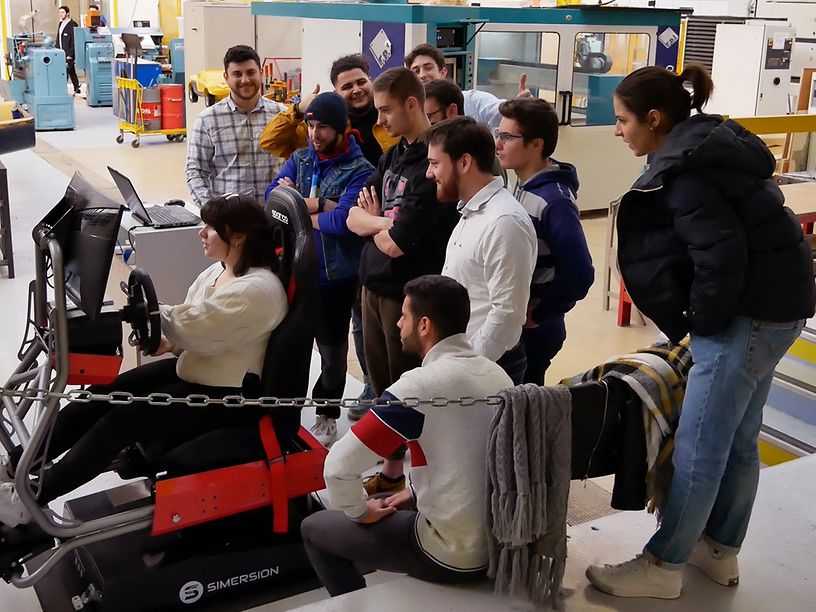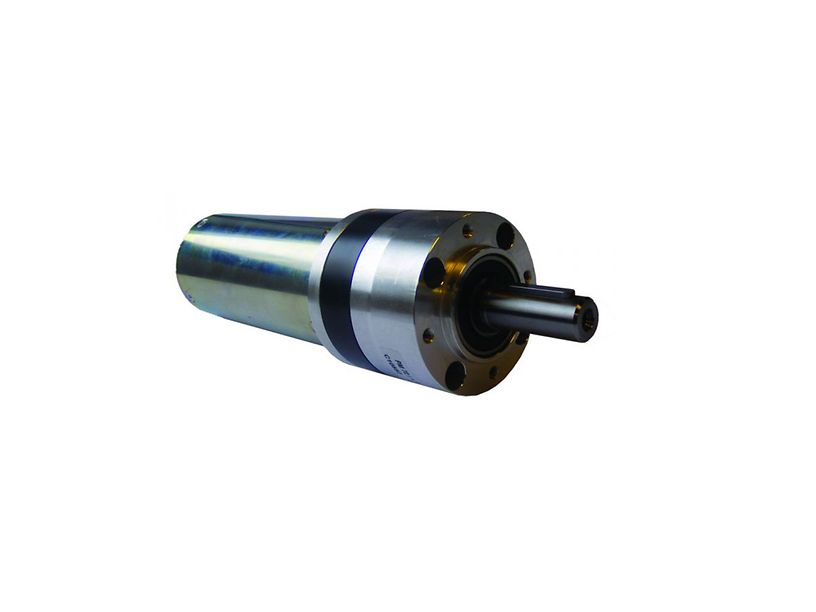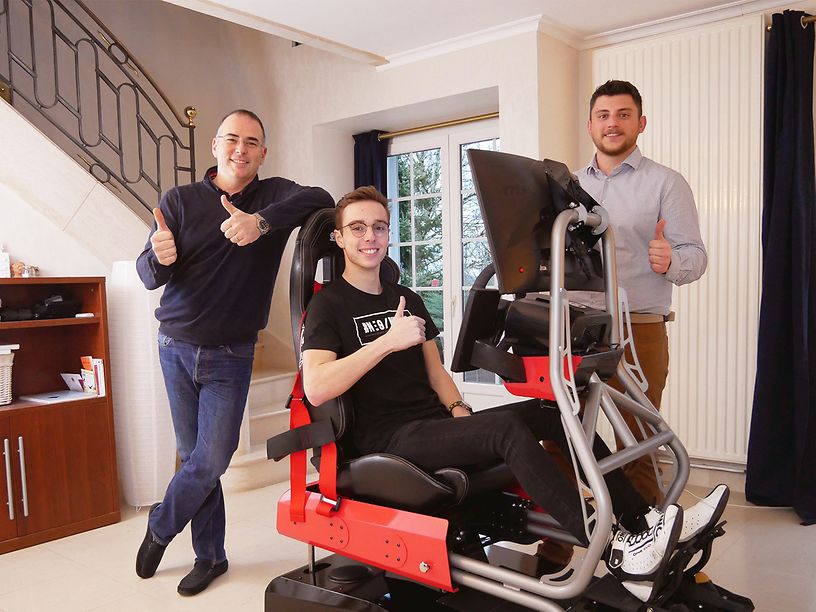maxon Story
As close as possible to the real sensations of driving


It's what every motor sports fan dreams of: experiencing the sensations of a real race from their living room. Simersion has developed Guépard // 2X, an immersive driving simulator designed for leisure professionals and consumers that plunges users into the heart of either a rally or a Formula 1 race, depending on the game selected.
Developed by two video game and car enthusiasts in Limousin, France, this simulator is the only one on the market that can be folded and therefore easily stored. Building on this success, Pierre Maquet and Pierig Bobet then adapted their product to create a flight simulator as well, Albatros // 2X, to capture the feeling of being an airline pilot. To find a custom motorization solution, the two engineers turned to the MDP x Buehler range from maxon France. This is the story of a bold design, made in France.
Providing an immersive experience
To provide the finest, most realistic simulation experience possible: That is Simersion's mission, whether you're driving a race car or piloting an airliner. At the start of their project, Pierre Maquet and Pierig Bobet were aiming at private individuals who were passionate about motor sports, like themselves. Then they became aware that their simulator was also very attractive to professionals in the indoor leisure sector. As a result, Simersion now offers a “Competition System,” a turnkey simulator installation for indoor go-kart tracks and other indoor activities. “During a typical karting session, the good karters are usually frustrated by not to being able to overtake the beginners, who themselves are frustrated at not to being able to drive around calmly without being jostled. Our simulator eliminates the difference in level by creating a virtual world for each participant,” said Pierre Maquet, president of Simersion. After a career in the French navy, the engineer created a design company before meeting partner Pierig Bobet and embarking on the Simersion adventure. “The other benefit of simulation is that we can do all the jackass things we want! The virtual cars don't get damaged, so we can even race with stock cars if we like,” added Pierre Maquet.
In a world where safety rules are increasingly restrictive, Simersion's driving simulators are a realm of freedom that is more than welcome. “Our simulator eliminates the difference in level by creating a virtual world for each participant."
Designed from scratch
In the amusement and simulation industry, one way to design a new simulator is to source components from a third-party company, such as actuators and a black box, and then build a chassis around them. This solution did not suit our two associates, who wanted to have control over their technology from start to finish. So they started from scratch. “Initially, we were looking for electric cylinders, but that option was not suitable for the power we needed. So we switched to electric motors. The university we were collaborating with told us that they regularly worked with maxon France, who provided effective motors and knowledgeable people. So we contacted them.”
Major constraints on motorization
Powerful motors
In terms of power, Simersion was faced with a number of constraints. Their specifications limited the onboard weight to 200 kilograms, including the 40 kilograms of equipment and the weight of the person. In addition, in order to relay realistic sensations, the team wanted to have substantial angular displacement, which would allow the users to lean over significantly. Whereas the simulators on the market offer only 4 degrees, Simersion made sure that their simulator could lean 18 degrees in either direction. “To be able to go from -18° to +18° in less than 2 seconds, we needed powerful, high-performance motors with a long service life. We couldn't afford to select motors that start to lose performance after 10 hours of operation,” explained Pierre Maquet, who refines the sensations of his simulator with the aid of professional drivers.
Reliable motors
The reliability of the motors was a key issue. “The price of our simulators is fairly substantial, so it was crucial that our motors meet the expectations of our customers. When you're promoting the ‘Made in France’ aspect and reliability, you just can't have products being returned due to defective motors,” said the Simersion CEO. The changes in speed and direction make considerable demands of the motors, so they have to be able to withstand the impact of intensive use.
Compact motors
Lastly, in order to provide a foldable and easily storable simulator, Simersion had to work out how to make it compact. To insert them easily into the base of the simulator, the motors had to be no wider than an arm. “Of course, when designing, we always hope for a ‘unicorn’ component: We'd like a motor no larger than a pen, with the required power, with sensor and brake included, for 30 euros. But in reality, you have to prioritize your criteria and settle for a horse,” said the Simersion designer with a grin.
How a customized motor system was created, with the MDP range from maxon France
Thanks to its selection of multi-technology drives from the world's leading manufacturers, maxon France has built up the widest motorization range on the market. Its niche is intelligent motion. With its MDP x Buehler range, maxon France is thus able to offer its customers customized solutions using standard products. Once the right mix of suppliers is found, maxon France puts the mechatronic solution together, so it can be delivered ready to use as a plug-and-play assembly.
To meet the needs of Simersion, maxon France constructed the following solution from the MDP x Buehler range: a Buehler motor 1.25.058 + HEDL encoder + IMS GEAR PM72 gearhead with a reduction ratio of 305, ensuring an output power of 141 W (16 rpm - 84 Nm). maxon France fitted the selected motor with an encoder controlled with the maxon EPOS board for its “holding torque” mode. Instead of the standard encoder, maxon France used a HEDL-type encoder so that it could use the EPOS4 70/15 card that provides the “holding torque” function. The holding torque allows the nominal torque to be applied to the effective axle of the geared motor when the speed is 0 rpm. Thus, if the motor is energized but the axle is stopped, it is impossible for the mechanism to move.


